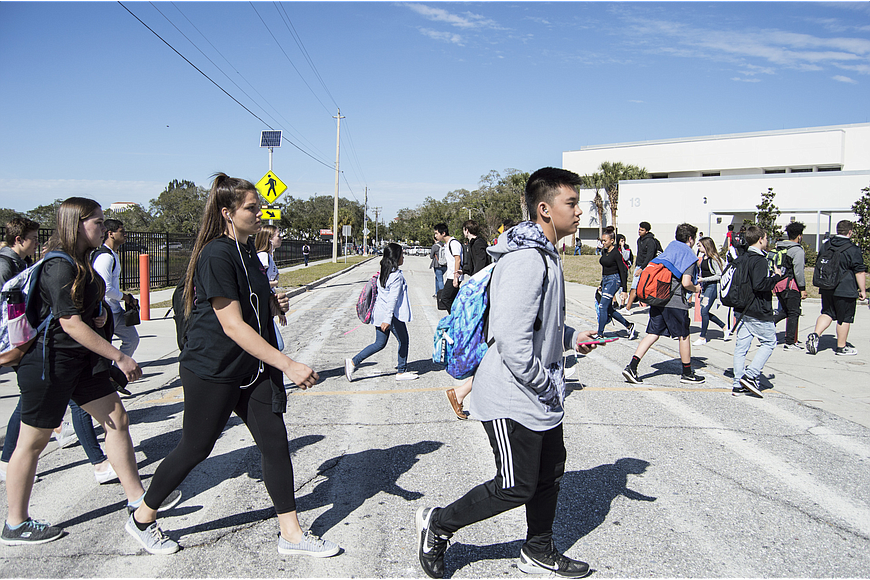- January 2, 2025
-
-
Loading

Loading

It’s no secret that COVID-19 has taken a toll on people’s mental health.
According to the Centers for Disease Control and Prevention, Americans have reported elevated adverse mental health conditions, such as anxiety, depression and suicidal ideas, since June 2020.
Now, Sarasota County School officials are focusing in on wellness services for both students and staff to ensure the well-being of the district’s population.
According to a 2018 mental health scan conducted by University of South Florida, there are more than 10,000 children with untreated mental illness in the county. Through the district’s mental and behavioral health services department, employees seek to identify those students and help get them treatment.
One way to do so is through the Adverse Childhood Experiences study, which asks students to self-report adverse experiences.
Debra Giacolone, the supervisor of mental and behavioral health services, said that if a student experiences one such event — such as abuse, neglect, parents’ divorce, an incarcerated guardian or a violent household — they are one and a half times more likely to have academic problems in school. They are two and a half times more likely to have behavioral concerns.
Higher ACE scores are linked to depressive disorders, anxiety, panic reactions, poor anger control and more.
The district was able to receive about $1.5 million from the state over the past two years as part of the Marjory Stoneman Douglas High School Public Safety Act.
The money helped facilitate a variety of programs including Positive Behavior Interventions and Supports in each school, training more than 1,000 staff members on recognizing mental health issues and implementing restorative strategies.
“We know that teachers are the best observers of students’ mental health needs because they are the people that spend the most time with students,” Giacolone said. “They’re trained diligently to be on the lookout for changes in behavior because that’s usually the No. 1 indicator that something isn’t going well for those students.”
Already this year, Giacolone said the district has seen more than 300 students meet with school support teams. The district this year increased mental health therapist staffing from 18 to 28 and continues to manage 19 interagency agreements for additional services.
The district also has a crisis text line that students can reach anonymously to get help. Giacolone said the line has served more than 500 individuals.
Students often are teamed up with navigators or counselors. Students and staff also are encouraged to use the district’s app Inner Explorer daily to focus on mindfulness.
One area for expansion, Giacolone said, is the possibility of a universal screening process that would identify kindergartners who might have behavioral or mental health needs.
She also would like to see the addition of a mental health therapist on all high school campuses. Elementary and middle schools already have access to mental health therapists.
The district is also working to improve employee well-being.
The district’s Employee Assistance Program has long included a free mental health component. The district also partners with Humana to offer confidential counseling to employees and their families.
EAP services allow for short-term counseling to help manage emotional issues, family relationships, financial issues and workplace concerns.
According to data collected by the district, the utilization of EAP services has increased each year since 2018. About 14.7% of employees used the services in 2018 compared to 24.5% in 2020.
The most common uses were connected to legal issues, relationship problems, anxiety/obsessive-compulsive disorder/phobia and stress.
Supervisor of Risk Management Lynn Peterson said both the increased usage and the most common concerns are most likely a result of COVID-19.
“We think the concerns coincide with being home more, having more family time and having more potential relationship issues,” Peterson said.
The district in 2019 began the Take 10 campaign, which encourages staff members to take 10 minutes for themselves daily. Through emails, staff members are provided with quizzes, articles and EAP services to encourage overall well-being.
Peterson said web logins for the Take 10 campaign have increased from an average of 791 in 2019 to 1,025 in 2020. Website visits increased from 3,422 in 2019 to 5,145 in 2020.
Peterson said that although the usage numbers seem small, not every employee utilizes the EAP services. Instead, some choose to seek care on their own.
“We only expect that to increase as more and more people pay attention and utilize those services,” Peterson said.